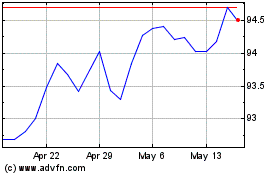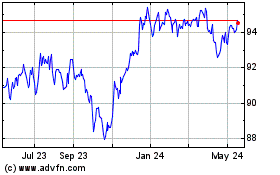Van Eck Launches Fallen Angel Bond ETF (ANGL) - ETF News And Commentary
April 11 2012 - 8:17AM
Zacks
Van Eck continues to be very active on the product development
front as the New York City-based firm has launched several new
products this year including an Indonesia Small Cap ETF
(IDXJ) and a Market Vectors Unconventional Oil
& Gas ETF (FRAK). In continuing with these novel
concepts, the firm has also just released the Market
Vectors Fallen Angel ETF (ANGL) in the bond space.
This intriguing product intends to take a close look at a
certain corner of the fixed income world, focusing in on ‘fallen
angel’ bonds. These bonds consist of securities that were once
investment grade but have fallen from grace and are now trading as
junk bonds (see Top Three High Yield Junk Bond ETFs).
According to Van Eck’s research, these bonds tend to have lower
default rates than their more traditional junk bond counterparts
while they also tend to operate at the higher end of the junk bond
credit quality spectrum as well.
Furthermore, the underlying index of this product has
outperformed both high yield corporate bonds and broader bond
indexes over long time periods—last decade—suggesting that they
could offer a better risk reward profile than other types of fixed
income securities. Additionally, thanks to the higher credit
quality of these bonds when compared to the broader junk markets,
they tend to outperform during bear markets, such as in 2008.
Fallen Angel Bond ETF In Focus
In terms of the portfolio construction, the junk bond ETF has a
heavy focus on industrial bonds, with the biggest allocations in
this space going to telecom and basic industries. Beyond this, the
financials segment accounts for roughly one-third of the total with
the biggest chunk in this regard going to the broad banking
industry.
For credit quality, over 90% of the underlying index has a
rating of at least ‘B’ with nearly 70% coming in at a ‘BB’ rating.
Furthermore, investors should note that the product has a portfolio
that is well dispersed across maturity levels, although all bonds
in the fund mature in 10 years or less, giving the index an average
modified duration of about 5.5 years (see Are Investors Taking
Another Look At Junk Bond ETFs?).
The ETF looks to pay out a yield of about 7.5%-- based on
average yield to worst—or about 6.8%-- based on the average
coupon—While this doesn’t compare favorable to many high yield bond
ETFs, it should be noted that the net expense ratio of 40 basis
points is roughly in line with most of the other competitors in the
space.
While the focus may be a little too concentrated for some
investors, the product could definitely see some inflows from those
looking to make a safer play on the junk bond space. “Although they
were downgraded from investment grade status, many Fallen Angel
issuers still retain a capital structure similar to investment
grade issuers, which may enable Fallen Angel issuers to enjoy
greater financing flexibility than the original issue high yield
issuers,” said Fran Rodilosso, Fixed Income Portfolio Manager at
Van Eck in a press release (see Van Eck Launches International High
Yield Bond ETF).
Fran continued, “Many Investors overlook Fallen Angels, but
historical data shows that in six of the past nine years ending in
2011, the U.S. dollar denominated Fallen Angels, as represented by
The BofA Merrill Lynch U.S. Fallen Angel High Yield Index, have
outperforming general U.S. dollar denominated corporate high yield
bonds, as represented by the Barclays Capital High Yield Very
Liquid Index.”
High Yield Bond ETF Competition
Although there aren’t any other ETFs that specifically target
the fallen angel bond market, there are plenty that focus in on
high yield bonds in general. As a result, there are a decent number
of competitors to ANGL in the high yield market, including a number
of heavily entrenched competitors such as HYG and
JNK which both have more than $11 billion in AUM
(read Looking For Income? Try High Yield Muni ETFs).
Arguably, the closest competitor could be the
PowerShares High Yield Corporate Bond Portfolio
(PHB). The fund targets the RAFI High Yield Bond Index
which looks to follow higher quality bonds in the junk segment,
focusing on securities in the top part of the below investment
grade category.
Currently, the product charges investors 50 basis points a year
and pays out a 30 Day SEC Yield of about 4.8%. Despite being more
expensive and paying a slightly lower yield, the junk bond ETF has
seen incredible interest from investors, having amassed nearly $850
million in AUM while seeing trading volume in excess of half a
million shares a day (see more at the Zacks ETF Center).
Given how popular PHB has been, even with its higher expense
ratio, ANGL could be an interesting choice for those looking for an
alternative in the space. ANGL looks to have a lower overall
expense ratio, while its yield projects to be comparable, if not
favorable, to PowerShares’ entrant in the space. As a result,
investors could see decent inflows into this product, especially if
markets remain weak and bond investing continues to intrigue
investors looking for high levels of current income.
Want the latest recommendations from Zacks Investment Research?
Today, you can download 7 Best Stocks for the Next 30
Days. Click to get this free report >>
Author holds a small position in PHB.
To read this article on Zacks.com click here.
Zacks Investment Research
Want the latest recommendations from Zacks Investment Research?
Today, you can download 7 Best Stocks for the Next 30 Days. Click
to get this free report
SPDR Bloomberg High Yiel... (AMEX:JNK)
Historical Stock Chart
From Apr 2024 to May 2024

SPDR Bloomberg High Yiel... (AMEX:JNK)
Historical Stock Chart
From May 2023 to May 2024
